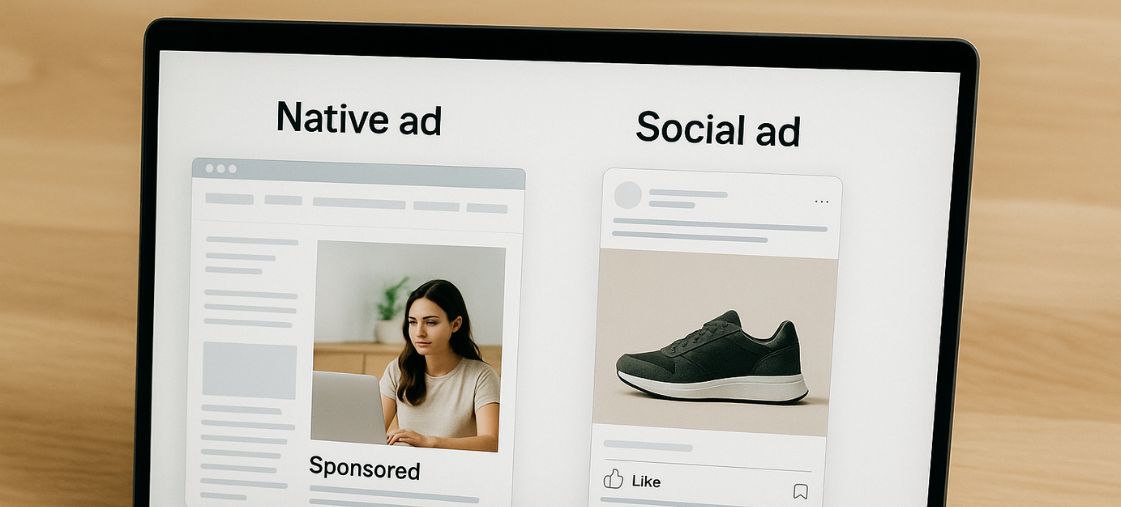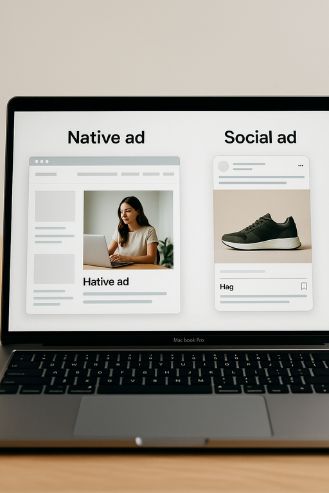
Native Ads vs Social Ads: Which One Builds More Trust?
Native Ads vs Social Ads is the debate marketers return to whenever building durable audience trust is the difference between a forgettable impression and a profitable relationship. Trust is not a vanity metric; it governs click quality, conversion likelihood, and long‑term brand lift. In a world saturated with feeds and content, how your message is framed — and where it appears — can signal credibility or raise suspicion in a split second.
Before we crown a winner, it helps to define both formats and the contexts where they shine. Native ads blend into the surrounding editorial experience in look and feel, often labeled with subtle disclosures such as “sponsored” or “promoted.” When executed well, they match intent and avoid disrupting the reading flow. If you’re new to the format, this concise native advertising overview is a useful starting point for understanding benefits and pitfalls.
Social ads, by contrast, are paid placements inside social platforms where targeting is driven by demographics, interests, and behavioral signals. They live among user‑generated content, comments, and reactions. This environment gives social ads a powerful advantage — built‑in social proof — but it also exposes them to skepticism if the creative feels incongruent with the community norms or if frequency becomes fatiguing.
Trust in advertising is ultimately psychological. People judge not only what you say but where and how you say it. Subtle cues like congruence with surrounding content, clarity of sponsorship, and perceived value shape whether your message feels helpful or salesy. For an interesting angle on consumer tolerance for interruptive formats, see this piece on the psychology behind pop ads that don’t feel spammy — the core lesson applies broadly: context, timing, and intent alignment matter as much as creative polish.

What “trust” really means in ads
When marketers say an ad is “trusted,” they usually mean audiences perceive the message as credible, relevant, and respectful. Practically, trust shows up as higher quality engagement (time on page, scroll depth), lower bounce rates, stronger assisted conversions, and positive brand recall weeks later. Four drivers matter most: transparency (clear sponsorship), relevance (solving an active problem), authority (publisher and brand reputations), and consistency (experience after the click matches the promise in the ad).
How native ads build trust
Native placements borrow the credibility of the host environment. On reputable publications, readers arrive with learning intent and an openness to long‑form context. If your sponsored story mirrors the editorial tone, delivers genuine insight, and avoids hard‑sell tropes, readers treat it like helpful content that happens to be paid for. Clear disclosures help; paradoxically, hiding sponsorship erodes trust faster than stating it plainly.
Two execution details consistently move the needle: topic‑audience fit and post‑click alignment. First, prioritize keywords and topics that reflect early‑stage research questions rather than “buy now” intent. Second, ensure the landing page continues the story — matching headline, visual tone, and next steps. Any jarring shift from thoughtful article to aggressive sales page will undo the trust you earned.
How social ads build trust
Social platforms offer unparalleled micro‑targeting and the immediate validation of comments, shares, and reactions. This social proof can accelerate trust when the creative features real people, recognizable experts, or user‑generated content. Short videos showing the product in context, carousels that teach something in a few swipes, and community‑centric copy (“Here’s how creators solved X”) tend to feel native to the feed.
The flip side is fragility: a mismatched persona, over‑targeting, or frequency overload can trigger ad fatigue and negative sentiment fast. Because social feeds are optimized for novelty and emotion, your ad must earn attention without feeling like a detour. Clear value in the first three seconds, visible branding without shouting, and human‑centered visuals reduce resistance.
Side‑by‑side: when to choose native vs social
If your goal is education and high‑intent discovery, native is often superior. It excels at storytelling, complex concepts, and thought leadership — ideal for B2B, high‑consideration B2C, and categories where context and nuance matter (finance, health, SaaS). If your goal is fast reach, testing creative angles, or catalyzing conversations around lifestyle products, social can build familiarity quickly, then hand off to deeper content.
- Choose native for top‑ and mid‑funnel education where you can deliver 800–1,500 words of genuinely useful material.
- Choose social for rapid creative testing, retargeting site visitors, and leveraging creators for authentic demos.
- Blend both by using social to seed curiosity (short video or carousel), then retarget with native content that answers next‑level questions.
A step‑by‑step framework to pick the right channel
- Clarify the trust objective. Is it credibility (be seen as an authority), reliability (consistency over time), or intimacy (being helpful to a niche)? Rank these.
- Map the journey. Identify the questions a prospect asks at awareness, consideration, and decision. Assign one key question to each planned asset.
- Score context fit. Rate native and social from 1–5 on intent alignment, attention quality, and noise level for your audience.
- Prototype creative. Draft a native headline and a social video hook for the same idea. If the concept needs 600+ words to make sense, native likely wins.
- Simulate the click‑through. Open your landing page and ask: does it continue the story promised in the ad? Fix mismatches before launching.
- Set trust metrics. Beyond CTR and CPA, instrument time on page, scroll depth, saves/shares, branded search lift, and post‑purchase NPS.
- Run a split test. Launch both channels with matched audiences and equal budgets for two weeks. Compare quality metrics, not just volume.
Creative principles that increase trust on both
- Lead with teaching. Start by solving a problem or naming a tension your audience recognizes. Advice beats adjectives.
- Be unmistakably transparent. Use clear labels (Sponsored/Ad) and state affiliations. Transparency invites, concealment repels.
- Borrow credible voices. Quote practitioners, cite sources, and feature real customers. User‑generated content can outperform studio polish.
- Match post‑click momentum. Ensure your landing page header, first paragraph, and primary CTA mirror the promise in the ad.
- Reduce cognitive load. Use scannable subheads, short paragraphs, and relevant visuals or diagrams when appropriate.
- Respect frequency. Cap impressions per user; scarcity can be more persuasive than repetition when trust is the goal.
Measurement: how to know you’re earning trust
Set up analytics to go beyond surface metrics. For native, emphasize time on page, engaged sessions, scroll depth, and assisted conversions over 7–28 days. Track which publications and topics correlate with view‑through conversions. For social, monitor saves, shares, comments that reference value (“bookmarking this”), and post‑view branded search. In both cases, add a short on‑site survey asking, “Did this content help you make a decision today?” and tag responses by channel.
Avoid these trust killers
- Clickbait headlines. Over‑promise and under‑deliver once, and your retargeting costs rise as audiences learn to ignore you.
- Jarring landing pages. If your ad promises a guide, don’t send people to a signup wall with no preview. Offer value first.
- Over‑targeting. Narrow audiences can create echo chambers that inflate early results but stall growth and erode credibility.
- Opaque pricing or claims. If you can’t substantiate it with data, a demo, or a guarantee, don’t headline it.
Budgeting and timeline tips
Allocate at least two creative variants per channel, and expect a four‑to‑six week learning period for stable readouts on trust metrics. For native, invest in editorial‑quality writing and design; for social, allocate for iterative video production and community management. Blend the channels by retargeting social engagers with deeper native content and retargeting native readers with concise social proofs (testimonials, quick demos) to close the loop.
Conclusion: the trust answer
So, which builds more trust — native ads or social ads? The honest answer is that contextual alignment plus execution quality beats channel loyalty. Native tends to win when audiences are researching and ready to read; social tends to win when community validation and fast iteration drive learning. The smartest teams use both in sequence: social to spark curiosity and identify resonant angles, native to satisfy that curiosity with substance, and then social again to reinforce proof. If you’re exploring tools to scale competitive research and placement strategy, solutions like Anstrex for native can help you study high‑performing creatives and publishers before you invest.


